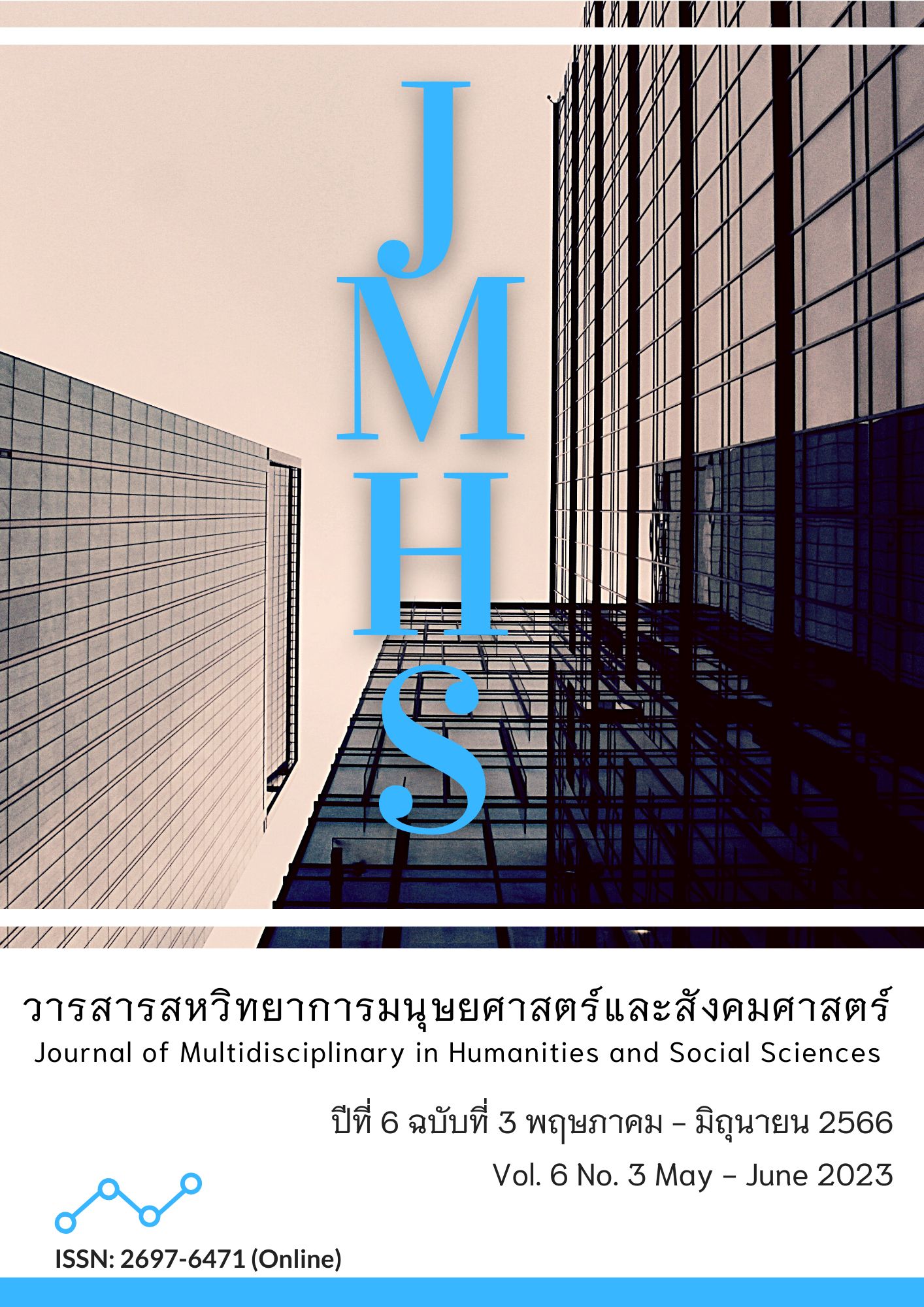Components of Trust of Online Consumers in Thailand
Main Article Content
Abstract
This research article presents the components of trust of online consumers in Thailand. The objectives aimed to 1) study the level of trust of online consumers in Thailand and 2) study the components of trust of online consumers in Thailand. This research used quantitative methodology. The tool was a questionnaire. The sample consisted of 440 online shopping consumers in Thailand, using the quota sampling method. Descriptive and inferential statistics were used to analyze the data. The research results were as follows: 1) The overall level of trust of online consumers in Thailand was high, and 2) The components of trust of online consumers in Thailand consisted of 7 components according to the conceptual framework. In the first three rankings, namely, the first is safety, the second is product competency, and the third is integrity and concern, with high component weight values of 0.94, 0.93, and 0.92 and predictive power (R2), including safety and product competency, 87 percent integrity and concern, and 85 percent, respectively. The findings of the research will be useful to online business entrepreneurs in Thailand in the development of strategies to build trust with online consumers.
Article Details

This work is licensed under a Creative Commons Attribution-NonCommercial-NoDerivatives 4.0 International License.
Views and opinions appearing in the Journal it is the responsibility of the author of the article, and does not constitute the view and responsibility of the editorial team.
References
กนกวรรณ รัตนปรีชาชัย และ จรัญญา ปานเจริญ. (2564). ความไว้วางใจที่มีผลต่อความจงรักภักดีในการซื้อสินค้าออนไลน์ของผู้บริโภค ในกรุงเทพมหานครและปริมณฑล. วารสารสุทธิปริทัศน์, 35(4), 25-41. สืบค้นจาก https://so05.tci-thaijo.org/index.php/DPUSuthiparithatJournal/article/download/256663/173889/953082
กระทรวงดิจิทัลเพื่อเศรษฐกิจและสังคม. (2564). ดีอีเอส เปิดสถิติ 15 ปัญหาซื้อขายทางออนไลน์ในรอบปี 64. สืบคนเมื่อ 20 เมษายน 2566, จาก https://www.mdes.go.th/news/detail/51765-64
ไทยโพสต์. (2565). เปิดสถิติภัยออนไลน์ 10 อันดับ ผงะ!หลอกให้รักเสียหายเกินพันล้าน. สืบคนเมื่อ 20 เมษายน 2566, จาก https://www.thaipost.net/x-cite-news/283584/
ธนาคารเพื่อการส่งออกและนำเข้าแห่งประเทศไทย. (2565). ตลาด E-Commerce ไทยในปี 2565 มี แนวโน้มโตไม่ต่ำกว่า 30%. สืบค้นเมื่อ 25 ธันวาคม 2565, จาก https://kmc.exim.go.th/detail/economy-news/20211230082019
เบญญา หวังมหาพร และ ทิพย์รัตน์ เลาหวิเชียร์. (2563). ผลของความไว้วางใจและคุณค่าที่รับรู้ได้ต่อการตั้งใจซื้อสินค้าผ่านทางสังคมออนไลน์เฟซบุ๊กของผู้ใช้ในเขตกรุงเทพมหานคร. BU ACADEMIC REVIEW, 19(2), 151-163. สืบค้นจาก https://so01.tci-thaijo.org/index.php/buacademicreview/article/download/240265/165932/865491
ปาณิศา ศรีละมัย และ ศุภชาต เอี่ยมรัตนกูล. (2561). อิทธิพลของความไว้วางใจที่มีต่อการตัดสินใจซื้อผลิตภณัฑ์ทำความสะอาดผิวหน้าที่มีส่วนผสมจากธรรมชาติ ผ่านร้านค้าปลีก. วารสารสหวิทยาการวิจัย: ฉบับบัณฑิตศึกษา, 7(2), 69-78. สืบค้นจาก https://so03.tci-thaijo.org/index.php/JIRGS/article/view/229650
ศุภนารี พิรส และ สุพัชร์การ พิรส. (2565). ปัจจัยที่มีผลต่อความตั้งใจซื้อผลิตภัณฑ์เครื่องสําอางที่เป็นมิตรกับสัตว์ในประเทศไทย. วารสารวิทยาการจัดการ มหาวิทยาลัยราชภัฎพิบูลสงคราม, 4(1), 71-87. สืบค้นจาก https://so03.tci-thaijo.org/index.php/jmspsru/article/view/259207
สำนักงานพัฒนาธุรกรรมทางอิเล็กทรอนิกส์. (2565). ETDA เผย Gen Y ทวงบัลลังก์ ใช้เน็ตมากสุด เกือบ 8 ชั่วโมงต่อวัน ฮิตสุด ดู LIVE COMMERCE ข้าราชการ-จนท.รัฐชนะขาดทุกอาชีพ ใช้เน็ตเกือบ 12 ชั่วโมงต่อวัน. สืบค้นเมื่อ 12 มกราคม 2566, จาก https://www.etda.or.th/th/pr-news/iub2022.aspx
Cardoso, A., Paulauskaite, ˙A., Hachki, H., Figueiredo, J., Oliveira, I., Rêgo, R., Silva, R., … Meirinhos, G. (2022). Analysis of the Impact of Airbnb Brand Personality on Consumer Involvement and Institutional Trust. J. Open Innov. Technol. Mark. Complex, 8, 104. https://doi.org/10.3390/joitmc8030104
Laparojkit, S., & Suttipun, M. (2022) The causal factors influencing repurchase intentions of local tourists in Thailand during COVID-19 crisis. Journal of Tourism Futures, 1-16. https://doi.org/doi: 10.1108/JTF-05-2021-0122
Lassoued, R., & Hobbs, J. E. (2015). Consumer confidence in credence attributes: The role of brand trust. Food Policy, 52(1), 99–107. https://doi.org/10.1016/j.foodpol.2014.12.003
Mayer, R. C., Davis, J. H., & Schoorman, F. D. (1995). An integrative model of organizational trust. The Academy of Management Review, 20(3), 709-734. https://doi.org/10.2307/258792
McAllister, D. J. (1995). Affect- and cognitive-based trust as foundation for interpersonal cooperation in organizations. Academy of Management Journal, 38(1), 24-59. https://doi.org/10.2307/256727
McKnight, D., & Chervany, N. (2014). What trust means in e-commerce customer relationships: An interdisciplinary conceptual typology. International Journal of Electronic Commerce, 6(2), 35-59. https://doi.org/10.1080/10864415.2001.11044235
Morgan, R. M., & Hunt, S. D. (1994). The commitment-trust theory of relationship marketing. Journal of Marketing, 58(3), 20-38. https://doi.org/10.2307/1252308
Mutairi, A., Yahyaoui, H., & Raafat, H. (2016). Lattice-based ranking for service trust behaviors. Knowledge-Based Systems, 102, 20-38. https://doi.org/10.1016/j.knosys.2016.03.011
Schumacker, R. E., & Lomax, R. G. (2010). A beginner’s guide to structural equation modeling (3rd ed.). New York: Routledge.
Tabachnick, B. G., & Fidell, L. S. (2007). Using multivariate statistics (5th ed.). New York: Allyn & Bacon/Pearson Education.
Taufik, D., van Haaster-de Winter, M. A., & Reinders, M. J. (2023). Creating trust and consumer value for true price food products. Journal of Cleaner Production, 390, 136145. https://doi.org/10.1016/j.jclepro.2023.136145


